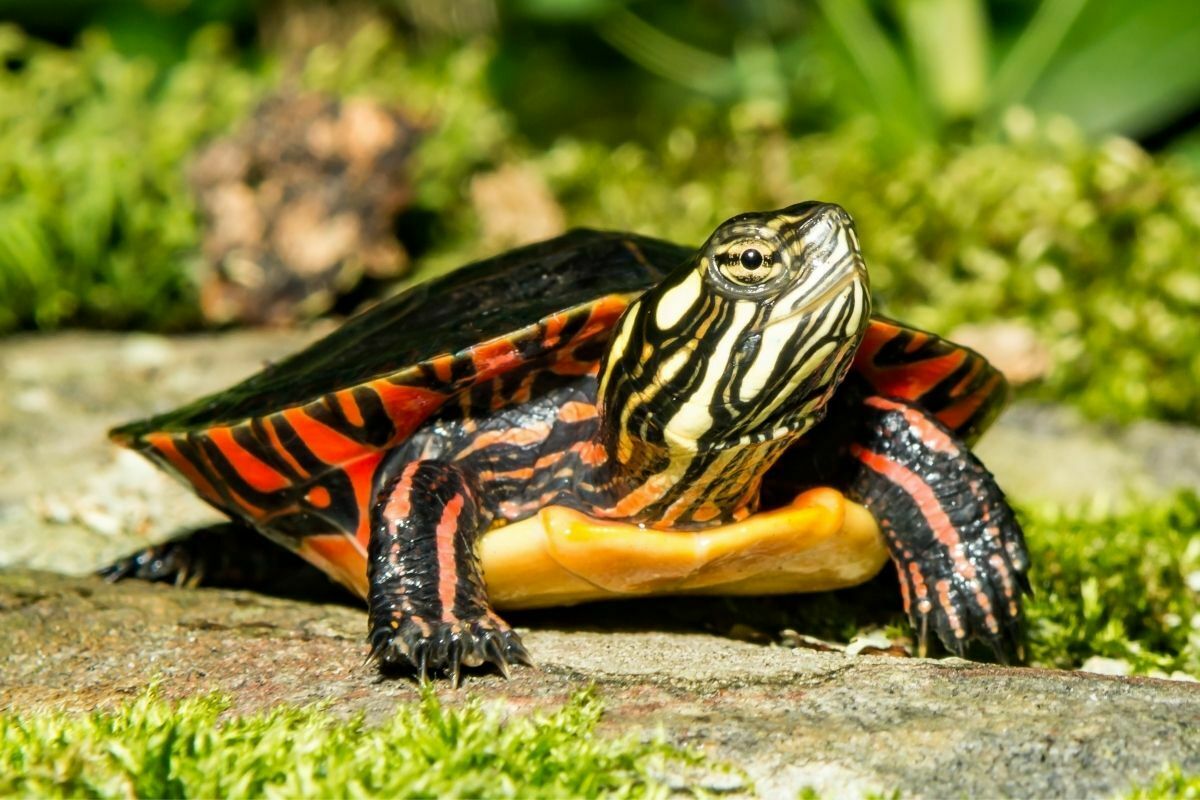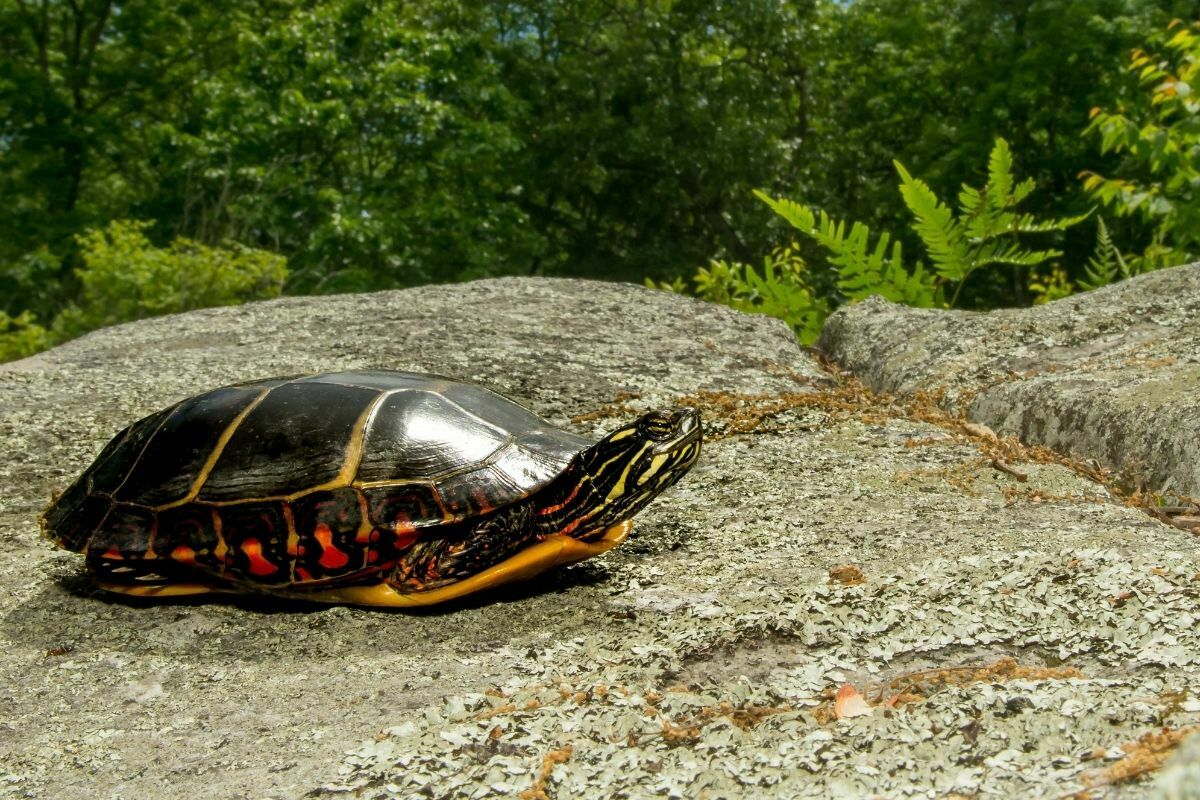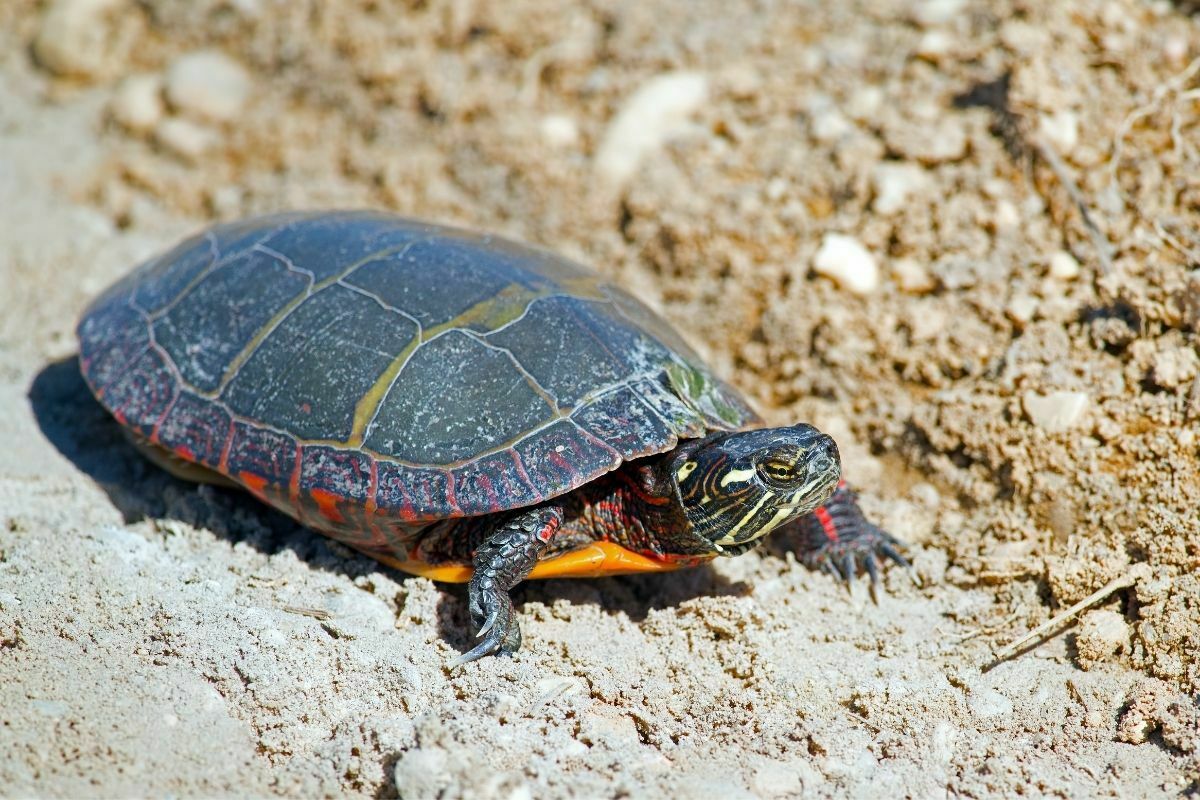The eastern painted turtle is a species of turtle in the family Emydidae. The genus name, Chrysemys, means “golden-shelled” and refers to its golden-colored carapace.

Eastern Painted turtles are found throughout North America and parts of Central America. They prefer moist areas near streams and rivers where they feed on aquatic insects, worms, snails, small fish, frogs, and other reptiles.
They also have a unique pattern of spots on their shells. These spots vary depending on the size of the individual. The larger the turtle, the more spots it has.
If you are looking at one of these beautiful turtles as a pet, then here is everything you need to know about how to care for your little baby Eastern painted turtle.
Eastern Painted Turtles
Eastern painted turtles have orange-yellow stripes. Their shells are usually black or brown. However, some individuals may be yellowish with dark markings.
These turtles are omnivores, so they can eat fresh fish, vegetables, fruit, and insects.
Eastern painted turtles can live for as long as 30 years if they are well cared for.
Eastern painted turtles are not very social animals, but they can cohabitate with other painted turtles in the same enclosure.
These turtles can live together peacefully with the right care and ample space.
Only when there isn’t enough space or not enough hiding spaces, then both male and female Eastern painted turtles may show territorial aggression.
How To Care For Your Baby Eastern Painted Turtle

Baby turtles are still fragile and vulnerable, so they need a little bit more care and attention than adult turtles.
Here are the key things you need to do to look after your baby Eastern painted turtle, so it grows into a strong adult.
Health Check
The first thing you should do when you get your baby turtle home is to ensure that he/she is healthy.
To check if your baby turtle is healthy, look at his eyes. If they appear dull, then this could mean that he/she needs to be checked by a veterinarian.
You should also keep an eye out for any signs of illness, such as diarrhea or vomiting.
Feeding Your Baby Turtle
The first thing that you should do when caring for an Eastern painted turtle is feeding them. If you want to keep your baby turtle healthy, you must provide him with food at least once per day.
Baby Eastern painted turtles are omnivores, and they aren’t fussy eaters. This makes it easier for beginners.
These turtles enjoy a varied diet, including:
- Aquatic plants, such as duckweed and water hyacinth
- Leafy greens, including lettuce and spinach
- Worms
- Insects
- Small feeder fish
- Fresh fruits and vegetables
Baby turtles love eating insects and worms. You will find that they like to nibble on crickets, grasshoppers, cockroaches, earthworms, and even mealworms.
However, you shouldn’t give them too many bugs because they might not digest them properly.
Your baby eastern painted turtle will start eating insects immediately, but you’ll need to introduce him/her to different types of food gradually.
Your baby pet turtle will also need plenty of calcium, vitamins, and proteins in its diet. This usually comes from fresh vegetables and fruit.
Fresh Water
Water is very important for your baby turtle. It helps him/her stay hydrated, and you should always ensure that your baby turtle has access to clean, fresh water.
As baby turtles can easily get sick due to poor water conditions, you will need to ensure that you have a good water filter in your tank.
The water temperature should be around 80 degrees Fahrenheit to make sure your baby Eastern painted turtle feels happy.
Heat And Light
If you don’t have a heated aquarium, then you should place a heat lamp inside the turtle’s aquarium to ensure adequate heat.
Heated tanks are best for baby turtles because they help prevent cold stress. Cold stress occurs when the temperature drops below 70 degrees Fahrenheit (21 degrees Celsius).
This can cause your baby turtle to become ill.
You will also need a UVB light which will help your new pet to produce vitamin D3 which is essential for him to build a strong shell.
A Large Tank
A good size tank will allow your baby turtle to move around easily and explore its surroundings.
It’s also a good idea to add a filter to your tank to ensure the tank stays clean for as long as possible.
An air pump is useful for keeping oxygen levels high and preventing respiratory problems.
Turtles need lots of space to roam around and stretch their legs. They also need somewhere to hide during the night.
Turtles also need to feel safe and secure to live comfortably, so provide some aquatic plants and shelters.
Your tank should be around 50 gallons in size.
Can Eastern Painted Turtles Live With Other Turtles?

Yes! Eastern painted turtles can coexist peacefully with other reptiles and amphibians.
However, if you’re planning on adding more than one turtle into your tank, then it’s better to get them used to each other slowly.
Don’t just throw two or three turtles together without giving them time to adjust to each other first.
Also, keep an eye out for signs of aggression between your turtles. If you notice any aggressive behavior, then separate them immediately.
How To Handle An Eastern Painted Turtle
Eastern painted turtles are easy to handle once you’ve got the hang of caring for them.
All you need to do is feed them regularly and make sure that they have enough room to roam around freely.
This will create a bond between you and the turtle. However, this turtle species is not very social.
Whenever you handle aquatic turtles, you must do so with care. Baby turtles are still vulnerable to diseases and shell damage.
Frequently Asked Questions
How Big Do Eastern Painted Turtles Get?
Eastern painted turtles grow up to be about 4 to 6 inches, and they can weigh 500 grams.
Are Eastern Painted Turtles Aggressive?
No, eastern painted turtles are generally peaceful animals. However, they may bite if they feel threatened or if there is a fight going on.
Conclusion
Eastern painted turtles are interesting animals that can live long and happy lives as pets.
The most important thing to remember when buying a baby turtle is that it is still vulnerable.
This means you need to look out for the right water conditions and ensure that your turtle has a proper diet.
The turtle enclosure should be big enough to allow your turtle to grow into it. After all, all baby turtles will grow up eventually.
